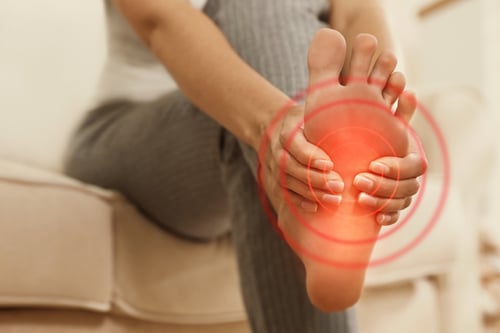
Morton's Neuroma refers to a painful condition that involves the ball of the foot, which is located near the third and fourth toes. Many patients who suffer from this condition claim that it feels as if they're standing on a fold in their sock or on a pebble in their shoe.
This foot condition occurs when the tissue surrounding the nerves leading to the toes thickens. The thickening of this tissue can cause pain in the ball of the foot. Patients often describe this pain as sharp and burning. The toes may also burn, sting or even feel numb.
Symptoms
In most cases, patients who have Morton's Neuroma exhibit no outward signs. However, patients often report experiencing these symptoms:
- Numbness or tingling in the toes
- Feeling as if there is a pebble in their shoe or a fold in their sock
- A searing pain in the ball of the foot
Causes
Most physicians believe that this condition is caused by injury or constant irritation and pressure to one of the nerves in the foot that lead to the toes.
Risk factors
Some of the risk factors that seem to contribute to this condition are as follows:
- Wearing ill-fitting or tight shoes like high heels and exposing the nerves in the ball of the foot to excess pressure
- Running, jogging and other high-impact athletic activities that cause the feet to be subjected to constant injury and trauma. Sports like skating and rock climbing that require individuals to wear tight shoes can also place extra pressure on the toes.
- Individuals who have foot deformities like hammertoes, bunions, flat feet and high arches are more likely to develop Morton's Neuroma.
Diagnosis
To diagnose this condition, your physician will likely press on the ball of your feet to feel for a tender spot or mass.
Imaging tests
Imaging tests can also be used to diagnose this condition. Certain imaging tests are more effective than others when it comes to diagnosing Morton's Neuroma.
- X-rays: Your physician will probably order X-rays for your foot to rule out other potential conditions like stress fractures.
- Ultrasound: An ultrasound works by using sound waves to create images of the foot's internal structures. Ultrasound is one of the best imaging tests for the identification of neuromas and other soft-tissue abnormalities.
- Magnetic resonance imaging: An MRI works by using a magnetic field and radio waves. This imaging test is also effective when it comes to creating images of soft tissues. However, this test is expensive and prone to false positives.
Treatment
Many physicians prescribe therapy to treat Morton's Neuroma. Patients also often wear foot pads and arch supports in their shoes to alleviate pressure on the impacted nerve. These foot pads and arch supports can be bought over the counter. Doctors can also prescribe a shoe insert that is custom-made for the individual.
Depending on the severity of the condition, doctors may prescribe more extreme treatments.
- Injections: Some patients have benefited from having steroids injected in the afflicted site.
- Decompression surgery: This surgery involves cutting nearby tissues and structures to relieve pressure on the nerve.
- Removal of the afflicted nerve: Surgical removal of the nerve may be required if all treatments fail to relieve the pain. Surgery is usually effective when it comes to reducing pain, but the procedure can lead to permanent numbness of the toes.






